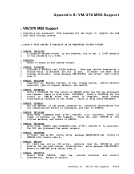alternate track support must permit the virtual .achine to escape fro.
the confines of itsminidisk to get to the alternate tracks assigned to
the defective tracks of that minidisk.Yet at the same time CP must still prevent the virtual machine from accessing other tracks that it
does not own.Since alternate tracks are assigned only in the conventional
alternate tracks cylinders at the high end of the real disk, CP does not
apply minidisk cylinder relocation values to a virtual machine's channelcommands that reference alternate tracks. Similarly, CP does not
unrelocate alternate track CCHH addresses returned by readhome address, by read record zero, in sense information, or for error recording.
Alternate~~~~~ ~ard~~g Operation and I.plications
The home address record (HA) on any track contains a flag byte withtwo bits that are involved in alternate track assignments. One bit, when
set to one, indicates that the track is defective and that the track
should have (and ordinarily does have) an alternate track assigned. The
count field of record zero of a track with this bit set should point to
(have theceRa address of) the assigned alternate track. The second bit
in the flag byte, when set to one, indicates that the track in which it
appears is an assigned alternate track. The count field of record zero
of an assigned alternate track should point back to~ave the ceHH
address of) the flagged defective track that it is assigned to.
Before using the pointer in record zero of a flagged track to get to
the corresponding alternate, it is considered goodfora for an operating
system to check the pointers bothways to see that each points to the
other. CP performs two-way checks of the pointers for seeks to an
alternate track initiated by Diagnose or bySIO in a virtual machine. For its own I/O, CP uses the forward record zero pointer without
performing a two-way check. Performing a two-way check would decrease
performance and should not be necessary since all of the record zero
pointers were checked in both directions by the Format/Allocateprogram (DMKF!T) when the CP-owned disk was originally formatted. !ot~: the DASD Dump/Restore (DDR) program also checks the record zero
pointers both ways when a tape is restored to a disk.
Except for those channelcommands that deal specifically with the home address and record zero, any atteapt to search or read or write on
a track that is flagged as defective results in a unit check with "track
condition check" indicated in the sense data.
operations on an assigned alternate track can also result in a unit
check with "track conditioncheck" indicated in the sense data. But in
this case it occurs when an attempt is made to leave the assigned
alternate track, not when the operation is reading or writing on the
track. The situations where trying to leave the alternate track results
in a track condition check are:• Any multi-track operation • A record overflow operation
The hardware does~1 generate a track
used to leave the track. This applies
seek head.
condition check when a seek is
to any kind of seek, includingWhen a channel program from a virtual machine SIO (or fro. a
Diagnose) is allowed to access an alternate track, subsequentCCWs in
the channel program .ust be preventedfrom accessing adjacent tracks in
CP Introduction 1-167
the confines of its
the defective tracks of that minidisk.
does not own.
alternate tracks cylinders at the high end of the real disk, CP does not
apply minidisk cylinder relocation values to a virtual machine's channel
unrelocate alternate track CCHH addresses returned by read
Alternate
The home address record (HA) on any track contains a flag byte with
set to one, indicates that the track is defective and that the track
should have (and ordinarily does have) an alternate track assigned. The
count field of record zero of a track with this bit set should point to
(have the
in the flag byte, when set to one, indicates that the track in which it
appears is an assigned alternate track. The count field of record zero
of an assigned alternate track should point back to
address of) the flagged defective track that it is assigned to.
Before using the pointer in record zero of a flagged track to get to
the corresponding alternate, it is considered good
system to check the pointers both
other. CP performs two-way checks of the pointers for seeks to an
alternate track initiated by Diagnose or by
performing a two-way check. Performing a two-way check would decrease
performance and should not be necessary since all of the record zero
pointers were checked in both directions by the Format/Allocate
pointers both ways when a tape is restored to a disk.
Except for those channel
a track that is flagged as defective results in a unit check with "track
condition check" indicated in the sense data.
operations on an assigned alternate track can also result in a unit
check with "track condition
this case it occurs when an attempt is made to leave the assigned
alternate track, not when the operation is reading or writing on the
track. The situations where trying to leave the alternate track results
in a track condition check are:
The hardware does
used to leave the track. This applies
seek head.
condition check when a seek is
to any kind of seek, including
Diagnose) is allowed to access an alternate track, subsequent
the channel program .ust be prevented
CP Introduction 1-167








































































































































































































































































































































































































































































